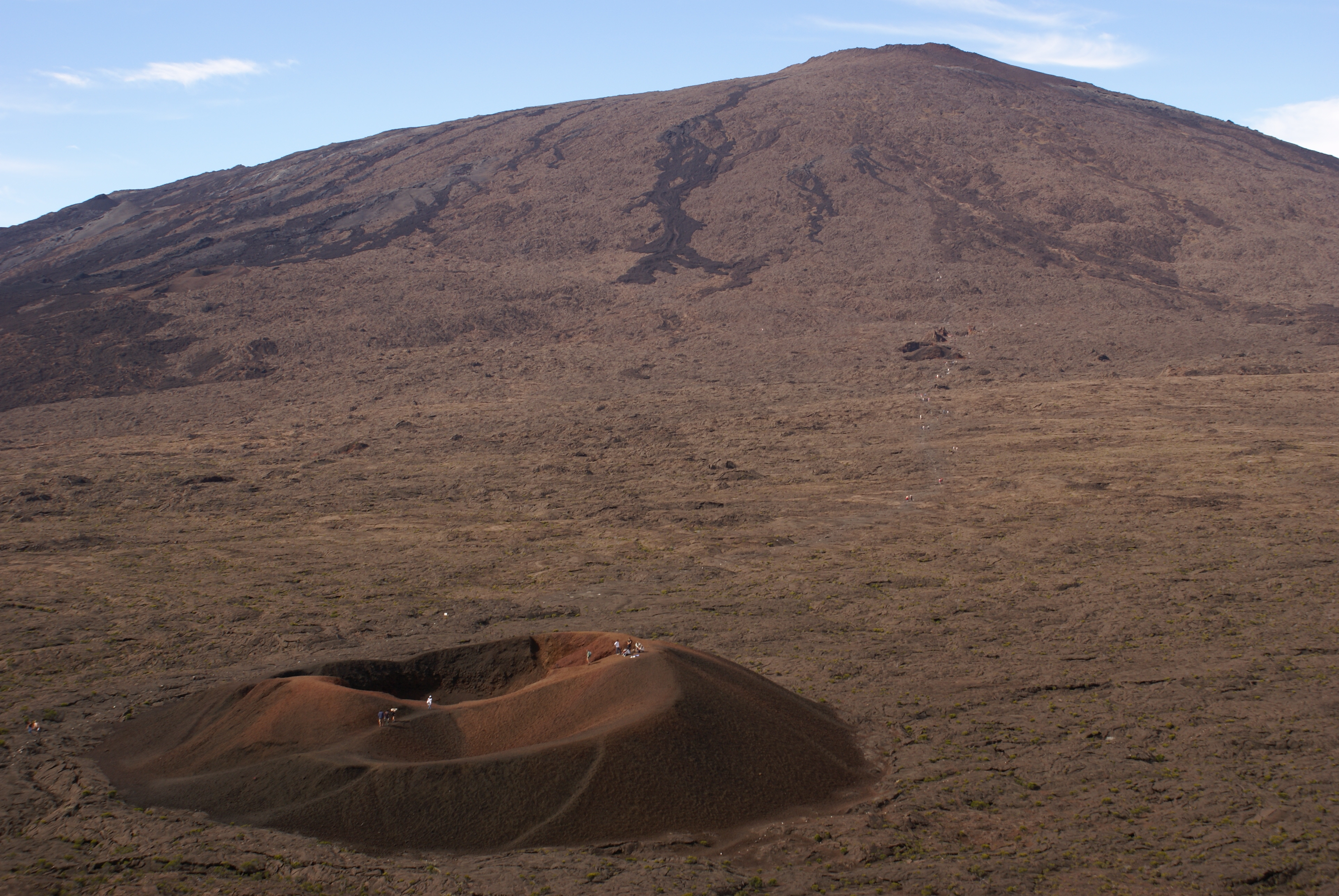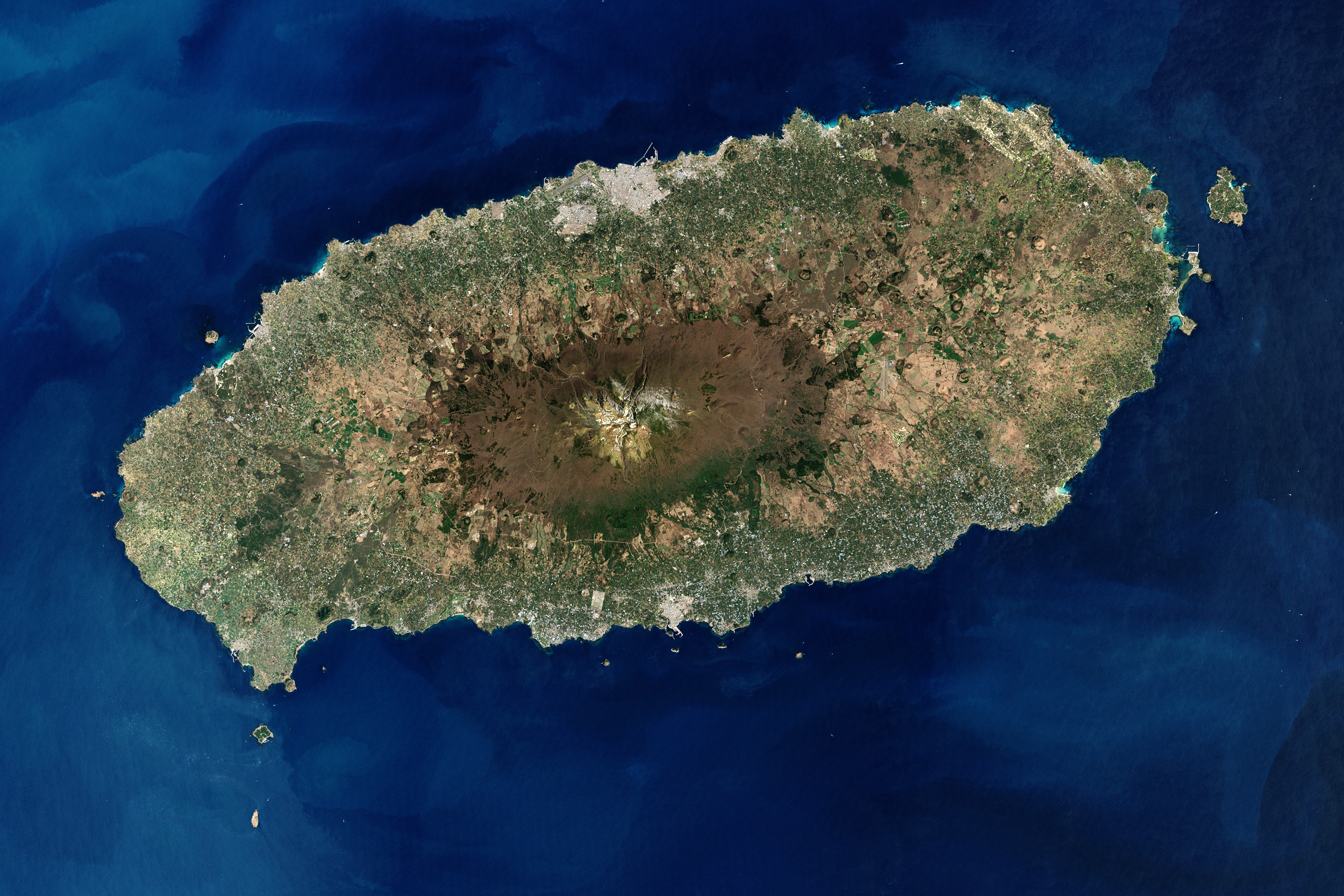|
Satellite Cone
A parasitic cone (also adventive cone or satellite cone) is the cone-shaped accumulation of volcanic material not part of the central vent of a volcano. It forms from eruptions from fractures on the flank of the volcano. These fractures occur because the flank of the volcano is unstable. Eventually, the fractures reach the magma chamber and generate eruptions called flank eruptions, which, in turn, produce a parasitic cone. A parasitic cone can also be formed from a dike or sill cutting up to the surface from the central magma chamber in an area different from the central vent. A peculiar example of multiple parasitic cones is Jeju Island in South Korea. Jeju features 368 " oreums" (; "mount"), which lie in a roughly lateral line on either side of the island's central dormant shield volcano Hallasan Hallasan is a shield volcano on Jeju Island in South Korea; it is the highest point of South Korea and the second-highest mountain in Korea overall, after Paektu Mountain. ... [...More Info...] [...Related Items...] OR: [Wikipedia] [Google] [Baidu] |
Volcano
A volcano is a rupture in the crust of a planetary-mass object, such as Earth, that allows hot lava, volcanic ash, and gases to escape from a magma chamber below the surface. On Earth, volcanoes are most often found where tectonic plates are diverging or converging, and most are found underwater. For example, a mid-ocean ridge, such as the Mid-Atlantic Ridge, has volcanoes caused by divergent tectonic plates whereas the Pacific Ring of Fire has volcanoes caused by convergent tectonic plates. Volcanoes can also form where there is stretching and thinning of the crust's plates, such as in the East African Rift and the Wells Gray-Clearwater volcanic field and Rio Grande rift in North America. Volcanism away from plate boundaries has been postulated to arise from upwelling diapirs from the core–mantle boundary, deep in the Earth. This results in hotspot volcanism, of which the Hawaiian hotspot is an example. Volcanoes are usually not created where two tectonic plates slide ... [...More Info...] [...Related Items...] OR: [Wikipedia] [Google] [Baidu] |
Flank Eruption
A flank eruption is a volcanic eruption which occurs on the flanks of a volcano, instead of at its summit. Such eruptions occur when the conduit connecting the summit to the magma chamber below is blocked, forcing the magma to move laterally. Overview At some volcanoes, flank eruptions are common, and occur along clearly defined rift zones. This is the case at Mauna Loa and Kilauea volcanoes in Hawaii, Piton de la Fournaise on Reunion Island, and Mount Etna in Italy. Flank and summit eruptions may occur at the same time. Where there are inhabited areas on the flanks of a volcano, flank eruptions may be more destructive and dangerous than summit eruptions. Flank eruptions may also trigger the collapse of the volcanic edifice, causing lateral eruption A lateral eruption or lateral blast is a volcanic eruption which is directed laterally from a volcano rather than upwards from the summit. Lateral eruptions are caused by the outward expansion of flanks due to rising magma. Breaki ... [...More Info...] [...Related Items...] OR: [Wikipedia] [Google] [Baidu] |
San Diego State University
San Diego State University (SDSU) is a public research university in San Diego, California. Founded in 1897 as San Diego Normal School, it is the third-oldest university and southernmost in the 23-member California State University (CSU) system. In Fall 2022, SDSU hit an all time high enrollment record student body of nearly 37,000 and an alumni base of more than 300,000. It is classified among "R2: Doctoral Universities – High research activity". In the 2015–16 fiscal year, the university obtained $130 million in public and private funding—a total of 707 awards—up from $120.6 million the previous fiscal year. As reported by the Faculty Scholarly Productivity Index released by the Academic Analytics organization of Stony Brook, New York, SDSU had the highest research output of any small research university in the United States in 2006 and 2007. SDSU sponsors the second-highest number of Fulbright Scholars in the State of California, just behind UC Berkeley. Since 2005, ... [...More Info...] [...Related Items...] OR: [Wikipedia] [Google] [Baidu] |
Jeju Oreum
Jeju Oreum (Hangul: 오름, Hanja: 岳) is a rising small defunct volcano in the Jeju Island in South Korea. The word "oreum" is the Jeju dialect which implies the parasitic cone [Hangul: 측화산, Hanja: 側火山 (also Hangul: 기생화산, Hanja: 寄生火山) and the origin of the word "oreum" is a noun type of the word "climb" (Hangul: 오르다). The name refers to a small volcano within a main volcanic crater in Jeju-do and is usually applied to the hill in Jeju. The cinder cone, symbolizing the oreum, is a typical form of Jeju Oreum.『제주의 오름』 (제주도, 1998) The Oreum is divided into pyroclastic cone, tuff cone and lava dome depending on the nature of volcanic eruptions. The pyroclastic cones are volcanic bodies formed by the accumulation of volcanic clusters released into the air by explosive eruption.네이버 지식백과, '오름' (한국향토문화전자대전, 한국학중앙연구원) More than 360 Oreums are distributed throughout Jeju Island from ... [...More Info...] [...Related Items...] OR: [Wikipedia] [Google] [Baidu] |
Shield Volcano
A shield volcano is a type of volcano named for its low profile, resembling a warrior's shield lying on the ground. It is formed by the eruption of highly fluid (low viscosity) lava, which travels farther and forms thinner flows than the more viscous lava erupted from a stratovolcano. Repeated eruptions result in the steady accumulation of broad sheets of lava, building up the shield volcano's distinctive form. Shield volcanoes are found wherever fluid low-silica lava reaches the surface of a rocky planet. However, they are most characteristic of ocean island volcanism associated with hot spots or with continental rift volcanism. They include the largest volcanoes on earth, such as Tamu Massif and Mauna Loa. Giant shield volcanoes are found on other planets of the Solar System, including Olympus Mons on Mars and Sapas Mons on Venus. Etymology The term 'shield volcano' is taken from the German term ''Schildvulkan'', coined by the Austrian geologist Eduard Suess in 1888 an ... [...More Info...] [...Related Items...] OR: [Wikipedia] [Google] [Baidu] |
Hallasan
Hallasan is a shield volcano on Jeju Island in South Korea; it is the highest point of South Korea and the second-highest mountain in Korea overall, after Paektu Mountain. The area around the mountain is a designated national park, the Hallasan National Park (, ). Hallasan is commonly considered to be one of the three main mountains of South Korea, along with Jirisan and Seoraksan. Names Hallasan is the highest mountain in South Korea and is worshipped by people as they believe that gods and spirits live on the mountain. Alternate English names for the mountain include Hanla Mountain or Mount Halla and older English sources refer to the peak as Mount Auckland. Hallasan is written in Hangul as if it were ''Hanrasan'' (); however, it is still pronounced as ''Hallasan''. In the past, Hallasan has been known by numerous other names in Korean including ''Buak'' (/), ''Wonsan'' (/), ''Jinsan'' (/), ''Seonsan'' (/), ''Dumuak'' (/), ''Burasan'' (/), ''Yeongjusan'' (/), and ''Hyeolm ... [...More Info...] [...Related Items...] OR: [Wikipedia] [Google] [Baidu] |
Flank Crater
A volcanic crater is an approximately circular depression in the ground caused by volcanic activity. It is typically a bowl-shaped feature containing one or more vents. During volcanic eruptions, molten magma and volcanic gases rise from an underground magma chamber, through a conduit, until they reach the crater's vent, from where the gases escape into the atmosphere and the magma is erupted as lava. A volcanic crater can be of large dimensions, and sometimes of great depth. During certain types of explosive eruptions, a volcano's magma chamber may empty enough for an area above it to subside, forming a type of larger depression known as a caldera. Geomorphology In most volcanoes, the crater is situated at the top of a mountain formed from the erupted volcanic deposits such as lava flows and tephra. Volcanoes that terminate in such a summit crater are usually of a conical form. Other volcanic craters may be found on the flanks of volcanoes, and these are commonly referred to ... [...More Info...] [...Related Items...] OR: [Wikipedia] [Google] [Baidu] |
Parasitic Cones
Parasitism is a close relationship between species, where one organism, the parasite, lives on or inside another organism, the host, causing it some harm, and is adapted structurally to this way of life. The entomologist E. O. Wilson has characterised parasites as "predators that eat prey in units of less than one". Parasites include single-celled protozoans such as the agents of malaria, sleeping sickness, and amoebic dysentery; animals such as hookworms, lice, mosquitoes, and vampire bats; fungi such as honey fungus and the agents of ringworm; and plants such as mistletoe, dodder, and the broomrapes. There are six major parasitic strategies of exploitation of animal hosts, namely parasitic castration, directly transmitted parasitism (by contact), trophicallytransmitted parasitism (by being eaten), vector-transmitted parasitism, parasitoidism, and micropredation. One major axis of classification concerns invasiveness: an endoparasite lives inside the host's body; an ect ... [...More Info...] [...Related Items...] OR: [Wikipedia] [Google] [Baidu] |
Volcanology
Volcanology (also spelled vulcanology) is the study of volcanoes, lava, magma and related geological, geophysical and geochemical phenomena (volcanism). The term ''volcanology'' is derived from the Latin word ''vulcan''. Vulcan was the ancient Roman god of fire. A volcanologist is a geologist who studies the eruptive activity and formation of volcanoes and their current and historic eruptions. Volcanologists frequently visit volcanoes, especially active ones, to observe volcanic eruptions, collect eruptive products including tephra (such as ash or pumice), rock and lava samples. One major focus of enquiry is the prediction of eruptions; there is currently no accurate way to do this, but predicting eruptions, like predicting earthquakes, could save many lives. Modern volcanology image:Icelandic tephra.JPG, Volcanologist examining tephra horizons in south-central Iceland. In 1841, the first volcanological observatory, the Vesuvius Observatory, was founded in the Kingdom o ... [...More Info...] [...Related Items...] OR: [Wikipedia] [Google] [Baidu] |







